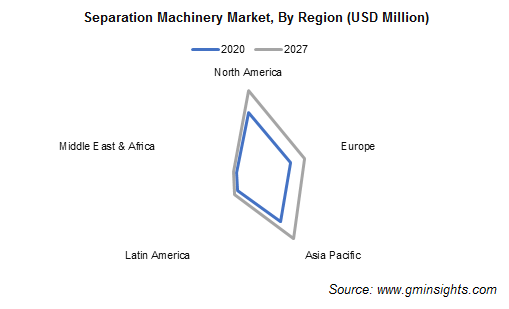Home > Industrial Machinery > Industrial Equipment > Tools > Separation Machinery Market
Separation Machinery Market Analysis
- Report ID: GMI2715
- Published Date: Feb 2021
- Report Format: PDF
Separation Machinery Market Analysis
The industrial centrifuges segment was the major product segment in the separation machinery market in 2020 and accounted for more than 35% market share. An industrial centrifuge is a machine, which is used for fluid or particle separation. These centrifuges rely on centrifugal force to separate heterogenous mixtures into components varying with density. Industrial centrifuges rotate at a high-speed with many revolutions per minute (rpm). This rotation induces an inward force, which is relative to the outward centrifugal force. This generated centrifugal force is hundreds of times greater than the force of gravity.
A heterogenous mixture of solid and liquid will suspend propelled by the force of gravity, given enough time. The same procedure is subjected to centrifugal force to cause separation and to save time. Industrial centrifuges are used in wastewater processing, chemical processing, pharmaceutical & biotechnological, fuel & biofuel, food processing, and mining & mineral processing industries.
According to the National Health Expenditure, healthcare spending in the U.S. grew by 4.6% in 2019, which is about USD 3.8 trillion. In the U.S., R&D investments of pharmaceutical companies have grown significantly in the past 15 years and more than doubled the publicly funded National Institutes of Health (NIH) expenditures in 2019. The growing trend will trigger new product development trends, which will boost the market for industrial centrifuges and separation machinery.
The separation machinery market for water and wastewater is set to surpass USD 40 billion in 2027. According to the UN, by 2050, over 40% of the world population will suffer from water shortage; therefore, the view that water is an inexhaustible natural resource must change. In North America, the Safe Drinking Water Act and Clean Water Act are regulated by the Environmental Protection Agency (EPA). The EPA has set treatment techniques and maximum contaminant levels that are essentially met by drinking water to be considered safe for consumption. This strict regulatory background is likely to fuel the market demand.
According to the Water Design-Build Council U.S., water and wastewater utilities spend approximately USD 50 billion a year to modify, rehabilitate, and expand their water & wastewater infrastructure. By the end of the next decade, utilities will reach USD 60 billion.
The increased spending on water treatment facilities can be attributed to the increasing demand for safe drinking water impelled by the depletion of fresh water sources and growing concerns among the population regarding the rising water scarcity, and recycling of wastewater for domestic uses. Increasing discharge of wastewater with rising need for clean water will offer opportunities for wastewater treatment facilities.
The U.S. industrial wastewater treatment sector has seen a transition from traditional filtration technology to the use of efficient centrifugal filters to other modified filtration systems. The constant progress in wastewater treatment has given rise to more effective filtration equipment. The growing and changing wastewater treatment facilities will create a positive impact for the market expansion.

The Europe separation machinery market revenue is projected to expand at around 4% CAGR during 2021 to 2027 driven by the growth in end-use industries. Chemical production witnessed a growth of 1.5% in the European Union in both 2018 and 2019. According to the European Chemical Industry Council, the total sales of European chemicals accounted to USD 612 billion in 2017.
Increasing expenditure in research & development activities and stringent laws on intellectual property rights have propelled the chemical industry. The growing chemical industry will have a positive impact on the separation machinery market. The chemical industry in Austria exceeded above USD 17 billion in 2016. The total chemical sales grew by 26.9% in the past decade in Austria. The driving factors of the growing chemical sales in Austria are high level of innovation and high level of specialization. Social stability in the region has also boosted the competitive environment for the regional chemical industry. Well-educated and skilled workforce will have a positive impact on the growth of the chemical industry.

